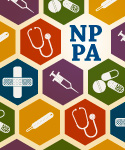December 2nd, 2015
A Melange of Medications
Charity Maniates, MSPA, MPH, PA-C
It’s unavoidable — treating the frail, confused, 80 year-old patient with congestive heart failure, atrial fibrillation, type 2 diabetes mellitus and chronic kidney disease in your office, emergency department, or hospital ward. In geriatrics, often acute presentations are the result of harmful medical interactions, resulting in falls, toxicity, delirium, or acute kidney injury.
Over time, many medications are prescribed with good intentions but are not reevaluated or stopped. The result is a melange of medication lists and prescriptions stashed in an older adult’s kitchen cupboard, used either inappropriately or accidentally. The arduous task of clarifying medications requires detective skills — especially when you’ve been given a handwritten scrap of paper listing twenty medications, many crossed out and rewritten with questionable doses.
 As a physician assistant or nurse practitioner, we are often the first to assess and initiate workup, order diagnostic tests, and tailor treatment plans for older adults. We can help to identify potentially harmful medication interactions, dose antibiotics for renal function, or consider alternative medications to reduce falls, delirium or worsening dementia. With all that is required of clinicians, delving into the pages of pharmacopoeia for guidance is simply daunting.
As a physician assistant or nurse practitioner, we are often the first to assess and initiate workup, order diagnostic tests, and tailor treatment plans for older adults. We can help to identify potentially harmful medication interactions, dose antibiotics for renal function, or consider alternative medications to reduce falls, delirium or worsening dementia. With all that is required of clinicians, delving into the pages of pharmacopoeia for guidance is simply daunting.
The Beers Criteria, first published in 2012, is a comprehensive list of potentially harmful medications for older adults extensively researched and published in the Journal of the American Geriatrics Society. The aim of the 2015 Beers Criteria is to create heightened awareness of potentially harmful medications to stimulate clinicians to weigh the risks and benefits of starting a mediation or to consider an alternative. Recognizing common drugs that carry potential for mishap — including first-generation antihistamines, tricyclics, peripheral alpha 1 blockers, sulfonylureas, and oral NSAIDs — is a good step in reducing polypharmacy. Below are a few medications highlighted in the “American Geriatrics Society 2015 Updated Beers Criteria for Potentially Inappropriate Medication Use in Older Adults” review, published in November’s Journal of the American Geriatrics Society 1:
- Proton-pump inhibitors are a new addition to the Beers Criteria due to the increased risk of C. difficile, fractures and bone loss and should not prescribed for >8 weeks. In the setting of chronic NSAID use or erosive esophagitis, a PPI course may be extended.
- It’s known that there’s an increased risk of mortality with first- and second-generation antipsychotics. The new update recommends avoiding antipsychotics in dementia patients or delirious patients with behavioral issues and, instead, to focus on nonpharmacological approaches. If the patient is a harm to themselves or others (as in psychosis), starting risperidone or quetiapine at the lowest dose possible may be considered.

- Digoxin, commonly used for rate control in atrial fibrillation, was newly added to the list of potentially harmful medications. Choose other rate control medications over digoxin due to elevated risks for mortality and hospitalizations. Higher doses are not shown to improve symptom management and lead to toxicity. So, avoid dosages > 0.125 mg/d if digoxin is the only option for atrial fibrillation and heart failure.
- It’s not surprising that benzodiazepines are still on the list, but this drug class frequently is prescribed among older adults in the community. According to the Beers Criteria, benzodiazepines increase risk of cognitive impairment, delirium, falls, fractures, and motor vehicle accidents. If pharmacologic treatment is required for anxiety, consider an SSRI or Buspar.
Of course, there are circumstances in which potentially harmful drugs need to be prescribed. Obviously, every clinical scenario is unique, so simply use your clinical judgement. Taking the extra time to review a medication list may give you the answer to diagnosing vague symptoms or a patient’s confused state. The older adult will be appreciative, and no one will fault you for paying attention to the details.
1 J Am Geriatr Soc. 2015 Nov;63(11):2227-46. doi: 10.1111/jgs.13702. Epub 2015 Oct 8.



What is missing in this discussion is the obvious value of communicating with a patient’s pharmacist. Pharmacists are far more educated in pharmacology, drug-drug and drug-disease interactions than MDs, NPs and PAs, and are an underutilized, tremendously valuable resource.
Thank you for taking the time to read my post and the salient reminder to proactively reach out to pharmacists. I can’t agree more – a pharmacist is an integral team member in sorting out drug prescription history and adverse drug interactions. Approaches to improve communication and collaboration with our local pharmacist are essential to reducing polypharmacy.
Charity
I believe it is a physician’s/physician assistant’s job to be thoroughly knowledgable about pharmacology, side-effects, drug-drug-interactions, and drug-disease interactions. A pharmacist does not see patients in a medical setting, so it just makes sense to me that we know more about these effects. At least that’s how I was educated. If a pharmacist can help, great, but when they know more than I do, that’s the day I should start remedial studying.
I agree it is the job of the physician, PA and/or NP to knowledgeable regarding pharmacology etc. Pharmacist do see patients in acute care and outpatient setting and have for sometime now. In fact, numerous studies have been published illustrating improved efficacy, medication safety and in some studies patient satisfaction has improved with a pharmacist as part of the medial team. Our training allows us a unique perspective and to suggest alternatives where untoward effects are occurring or perhaps prevent them all together. Are we a substitute for the other listed providers? Absolutely not. However pharmacist are a vital part of team with their area of expertise. and quickly becoming the standard of care in many settings. I feel the patient’s best interests should be the priority with contributions for all members of the medial team: provider, mid-level, nursing, social work, care management, pharmacist etc.
Ms. Maniates has identified some critical issues regarding elderly patients and the myriad risks of polypharmacy. However, in addition to what she mentions, there are many other opportunities to reduce and even eliminate risk. The primary resource many physicians and primary care providers underutilize are pharmacists, the drug therapy experts. We see patients much more frequently as they visit our pharmacy for refills and self-care products, and we have valuable information about medications, adherence, and specific refill dates. We also conduct safety assessments that includes the use of comprehensive software programs to help identify potentially risky situations; hence the many phone calls we make to physician offices to change therapy. Another way to help reduce risk is to improve communication and information sharing. Often we receive prescriptions and we have no idea why the medication was prescribed, nor does the patient. If an indication was included on every prescription this would greatly enhance the patient counseling encounter at the pharmacy. In addition, there would be more opportunities to obtain and share information with patients, improving chances for better outcomes and to more proactively identify situations where changes should occur. Yes any medication use in the elderly is risky, and polypharmacy is a huge cause of morbidity and mortality, but it doesn’t have to be that way. Collaboration and communication with your pharmacy colleagues can greatly improve patient outcomes and our patient’s quality of life.
Dan Krinsky – thank you for your thoughtful response to my post. Stimulating conversation and ways to improve communication and ultimately prevent adverse drug reactions is essential. In medicine, collaboration and communication is always the underlying key to effective patient management. I appreciate your input.
Charity
Perhaps the most important part of a geriatric evaluation is a review of the medication list. Maniates makes an excellent point here. We geriatricians frequently see patients with mile long lists. When asked to bring in the actual bottles, sprays, OTCs, etc –the best way to evaluate a patient’s med list — sometimes they are brought in a large file box or bulging bag. Inappropriate meds are often found, plus a number of otherwise appropriate meds that could safely be discontinued. We are all wise, geriatricians or no, to be aware of this.
The vast majority of elderly patients are on medications, have been on medications for decades, ostensibly to treat risk factors for conditions and diseases they have long since outlived the complications. Those agents usually designed, with dubious benefit to prevent a premature event. One look at the list and one will see numerous receptor site and drug-drug interactions which produce a myriad of side effects, some of them deadly. I take every opportunity to recommend discontinuing those with medication reconciliation at discharge and try not to treat with yet another agent that may produce an adverse drug reaction.